Tennis Elbow Treatment in Perth, Australia
Tennis elbow is one of the most common type of elbow pain that manage and treat in clinic. In this article, I hope to shed some light on what it means to have the notorious “tennis elbow”, what it can be like having it, what we look out for and most importantly the treatment, management and rehabilitation side of it.
This condition can be very misunderstood by clients who more often than not have sought out self diagnosis via Google (General Population) or Instagram (Millennials) before coming in for Physiotherapy treatment.
Tennis Elbow Terminology
Common Synonyms for Tennis elbow: Lateral Epicondylalgia, Lateral Epicondylitis, Tendinitis (Despite it not being a tendinitis, is still a very common phrase/ misconception to describe this condition; reason being there is no inflammation in the involved tissues) & Elbow Tendinosis.
Fun fact it used to be termed “Lawn Tennis Elbow” in the 1800s pre-modern physiotherapy era.
How would you know if you have tennis elbow?
Here’s what I know, an estimated 40% (That’s one shocking figure of a little under half!) of tennis players experience it at some point in their Tennis playing hobby/career this number fluctuates between 30-40% depending on where you grab the research figures from. It is also present in 3 out of 100 of the otherwise health population. While it may affect tennis players more than regular folks, it tends to be more common in the 33-55 year old age group.
Let’s start by asking, how does tennis elbow start out?
The back of forearm pain can begin after a period of performing activities that involve plenty of repetitive twisting, gripping and bending/straightening the elbow. This cause is known as excessive use and is generally the most common potential catalyst for the tendons to undergo an injury driven change.
If you are an avid racket sport player/ athlete in the case of Squash, Badminton, Tennis; the nature of striking a fast moving ball/shuttle during a backhand stroke on long lever puts tremendous potential strain on the outer elbow. Occasionally, Golfers (Both Tennis and Golfer Elbow risk), Baseballers, Cricket players can also develop this tenderness in the elbow from major sporting overuse.
For office workers, Australian Tradies, e-sport players and occasional mechanical keyboard warriors elbow pain can originate simply by having plenty of manual work, poor desk ergonomics, workflow and posture. It is handy to lookout for how you may be sustaining your wrist posture and position during lengthy hours at the desk.
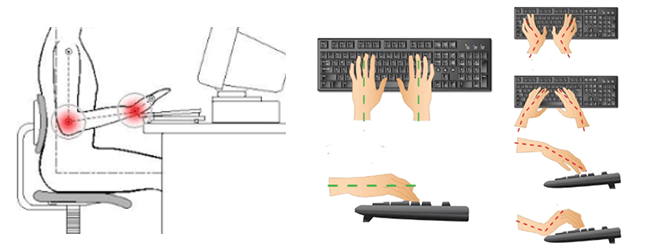
Time to Develop Elbow Pain
As in most cases, this is a condition stemming from overuse & repetitive loading of the extensor tendons of the wrist and elbow. Majority of clients will state that the pain gradually creeps up on them with a slow increase in intensity. This pain can be dull, achy and tender in the beginning, but at the advance or later stage of the injury suddenly change into a sharp sensation most pronounced when using the specific muscles. Rarely does it occur, but there are incidences of sharp sudden shooting pain that can be severe (In this cases – it is deemed best to seek help or a professional).
While the time-span may take months to progressively worsen or follow a pattern of briefly resolving only to return once-more. Some people who may be weakened or deconditioned can also develop this from a specific “incident” – meaning a once off event/ action/ task cascading into a lengthy period of pain.
What does it feel like to have it?
For starters your outer elbow muscles (common extensor origin or tendon origin) will feel tender or sore to poke. Gripping with the arm twisted in pronation (Thumbs Down) can aggravate the pain. This point in your arm is where most of your outer finger, wrist, gripping, elbow muscles connect to. This point in the arm also serves as a focal point of force (Meaning tears, strains, aches, pains and injuries often end up here). ‘Pain Free’ Grip strength on the painful side will also be weaker than your other arm, by a huge margin. And of course, your wrist will be weakened and have movement limitations (Flexing & Extending)
Time to Develop Elbow Pain
As in most cases, this is a condition stemming from overuse & repetitive loading of the extensor tendons of the wrist and elbow. Majority of clients will state that the pain gradually creeps up on them with a slow increase in intensity. This pain can be dull, achy and tender in the beginning, but at the advance or later stage of the injury suddenly change into a sharp sensation most pronounced when using the specific muscles. Rarely does it occur, but there are incidences of sharp sudden shooting pain that can be severe (In this cases – it is deemed best to seek help or a professional).
While the time-span may take months to progressively worsen or follow a pattern of briefly resolving only to return once-more. Some people who may be weakened or deconditioned can also develop this from a specific “incident” – meaning a once off event/ action/ task cascading into a lengthy period of pain.
What does it feel like to have it?
For starters your outer elbow muscles (common extensor origin or tendon origin) will feel tender or sore to poke. Gripping with the arm twisted in pronation (Thumbs Down) can aggravate the pain. This point in your arm is where most of your outer finger, wrist, gripping, elbow muscles connect to. This point in the arm also serves as a focal point of force (Meaning tears, strains, aches, pains and injuries often end up here). ‘Pain Free’ Grip strength on the painful side will also be weaker than your other arm, by a huge margin. And of course, your wrist will be weakened and have movement limitations (Flexing & Extending)
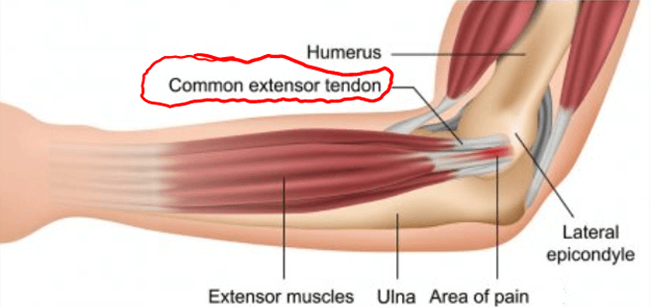
Simple actions like shaking hands, using a screwdriver, opening doorknobs and jars; hammering nails, lifting boxes, scrubbing plates, squeezing/ drying a wet towel, pinching or bending your wrist backwards can all produce painful sensations.
If it is chronic or has been affecting you for long periods, the lack of strength can also make it’s way to the shoulders in the form of weakness when lifting or rotating them.
Self Testing for Tennis Elbow
Here are some simple Tests you can try to do at home to determine if you have tennis elbow (Note: These tests can be wrongly interpreted – it is often best to seek your doctor or physiotherapist to rule out other causes of your pain)
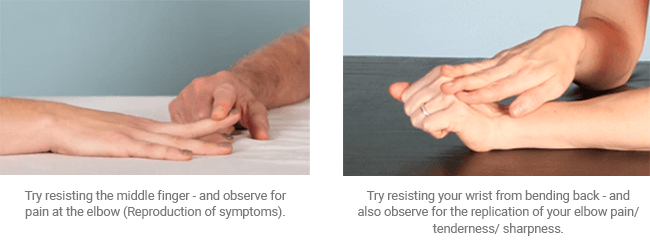
What goes on in the Elbow Tendons and My Body?
Radiological imaging such as MRI, Ultrasound scans will typically reveal some blood vessel infiltration (Angiofibroblastic hyperplasia) and messy collagen formation in affected tendons.
Motor Control Changes:
While you may notice a weakening in pain-free grip, wrist movements and shoulder movements (Abduction & Rotation) another thing that may start begin to develop are poorer reaction time and a change in gripping posture.
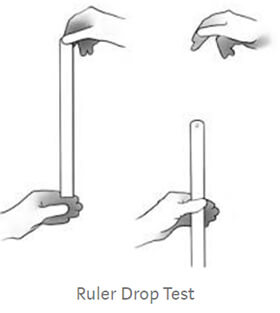 It is observed that chronic tennis elbow clientele tend to utilize less wrist extension when it comes to gripping objects! In a normal elbow and wrist – we tend to extend or bend our wrists backwards to maximize grip strength, it is how our bodies were invented to utilize a concept known as length-tension relationship. This concurrently would suggest that those with tennis elbow inadvertently develop poorer strategies for using their wrist.
It is observed that chronic tennis elbow clientele tend to utilize less wrist extension when it comes to gripping objects! In a normal elbow and wrist – we tend to extend or bend our wrists backwards to maximize grip strength, it is how our bodies were invented to utilize a concept known as length-tension relationship. This concurrently would suggest that those with tennis elbow inadvertently develop poorer strategies for using their wrist.
Speed may also be reduced – there is a clinical test called the ruler drop test, and it is shown that tennis elbow may also cause individuals to have a poorer reaction time when it comes to catching a falling object (at regular gravity speeds of 9.8ms)
What’s my outlook if I have this?
This is where some eyebrows will be raised. From treating plenty of cases over the years we do know that some chronic painful presentations will take a longer time to heal. The recovery period of tendon conditions, dysfunction and pain may last from 2 weeks to 2 years. When a client comes in – I often take note and examine their complaints and symptoms and superimpose their thoughts, beliefs and feelings onto a short form PRTEE Questionnaire (Patient-Rated Tennis Elbow Evaluation). This typically provides an indication on how their prognosis may be.
To put it bluntly; clients who have great outcomes usually report having elbow problems no longer than 3 months, and have no complicated symptoms. Whilst clients who have the tendency to have a poorer outcome usually report higher levels of pain (with neck, shoulder and arm pain), have sensory changes and lifestyle challenges to overcome (Such as high-stress levels of both a physical, chemical and emotional nature), it can often times mean that the type of repetitive work/ labor that they perform on a day to day can slow down their ability to make a speedy recovery.
To put a positive note on this – getting treatment for the sore elbow does always seem to help provide a reduction and make the tendon pain much more manageable.
Differential Diagnosis (How can I be really certain if it is Tennis Elbow)
If you have pain coming from the outer elbow (we physios call it the lateral side of the elbow), it doesn’t necessary mean it is tennis elbow, this is where the differential diagnosis can come in handy. Let’s take a look at what it can also potentially be:
More Common: Tennis Elbow, Muscular Strain/ Tear
More Uncommon: Radial Tunnel Syndrome, Radiohumeral Synovitis, Rotatory Instability
Dangerous Conditions: Fractures, Loose Bodies, Dislocations, Osteochondritis Dissecans.
Visiting a professional is paramount in obtaining a sound diagnosis and a treatment plan. It is worth noting that Osteochondritis dissecans can be dangerous and must be picked up early.
Referred Pain
The subject of pain can always be a tricky trail. Where pain is felt in the elbow – can occasionally originate from other parts of the body. This is termed referred pain (One area in jeopardy referring pain to be felt elsewhere)
Myofascial Trigger Points (Painful Muscle Knots) can often be to blame. The common muscles that can refer to the elbow are scalenes, supraspinatus, infraspinatus, triceps.
Below are some examples of how shoulder muscle pain can reflect on the arm and even the elbow region.

Radiculopathy of neck can provide an array of symptoms that bear close resemblance to that of the description of tennis elbow. This type of pain is typically caused by a pinched nerve in the neck that produces pain, weakness, numbness further down the upper limb. 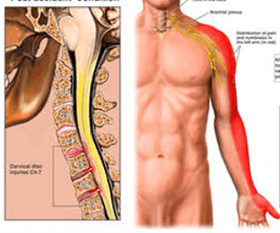 Again this is multifactorial and could come from a variety of causes such as spine narrowing, disc herniations, degenerative joint disease and bone spurring. The Physiotherapy treatment and management for this will be different.
Again this is multifactorial and could come from a variety of causes such as spine narrowing, disc herniations, degenerative joint disease and bone spurring. The Physiotherapy treatment and management for this will be different.
Central Sensitization or Sensory Changes
Central sensitization is becoming ever more popular in the medical world as a model to explain chronic, lingering, fatiguing pain. This happens when our brain becomes conditioned to having persistent pain and latches on to it.
In an spirit of oversimplification, central sensitization is where;
Pain tends to beget pain.
Even More pain begets evermore pain.
We know that there exists a pain cycle continuum in most tendinopathies or tendon conditions. By this model, advise is often given to quickly seek help to diminish the source of pain and return to regular activities of daily living (Assuming those activities are performed as safely and as ergonomically savvy as possible)
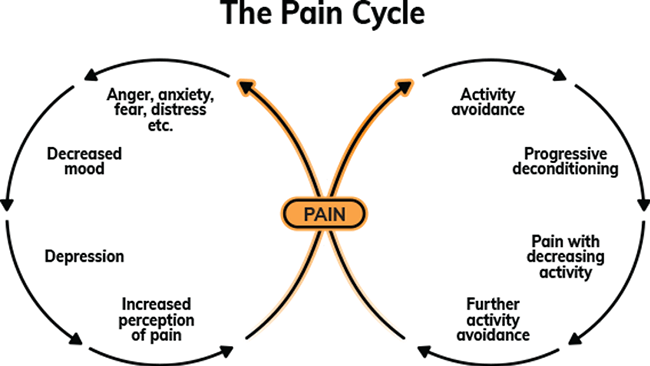
While more rare and obscure (but shouldn’t be ignored) – clients may come in reporting sensory changes in the form of pain spiking in the elbow when cold is applied. (Icing may numb it temporarily but make it worse later on)
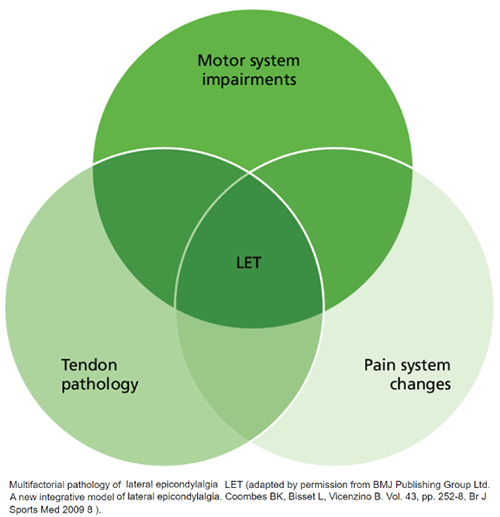
Treatment for Tennis Elbow
I have always found this systematic top down approach to work wonders for addressing such a condition.
Assess -> Educate -> Treat -> Rehabilitate -> Prevent
- Assess the client to obtain the best working diagnosis (Medical Imaging may be required for confirmation and to rule out differential causes)
- Educate the client on what is happening to their body and empower them in understanding the pathophysiological changes. Clients who choose to take the time to learn more tend to be more optimistic.
- Treatment aims to provide some physical therapy to aid recovery, pain relief, range of motion and therapeutic window for rehabilitation. Clients who are compliant, and willing to try tend to have great outcomes.
- Rehabilitation is extremely important for the body to lay down the foundations towards recovery. More often than not; those who are diligent (Safely & Responsibly) will have better results.
- Prevention, enough said nobody wishes harm to play an encore. Having the necessary correction and maintenance for your body can play a huge role in long-term wellness. Adjust your time preference accordingly.
Physiotherapy treatment is quite wide and can comprise of interesting techniques. We can mobilize joints, dry needle hypertonic muscles, use mulligan techniques to ease pain & meaningfully reduce pain input, floss/tension nervous nerves, release trigger points/ muscle knots, correct muscular imbalances, improve muscular synergistic relationships, prescribe therapeutic exercises… And the list goes on.
Prevention of Tennis Elbow
There are preventative measures that should be taken long before you develop any symptoms of tennis elbow. This can vary from case to case, if you deem yourself in a position prone to develop lateral epicondylalgia, speak to a healthcare professional.
What the general public may not often know of is; that reducing adipose tissue, chronic inflammation (Smoking, diet) can be a method of preventing this from occurring (More on the intricate Science behind this in future articles).
The Multi-Disciplinary Approach at Perth Wellness Centre
Here’s where I tell you about my workplace which is Perth Wellness. We pride ourselves in taking a team approach to managing cases.
Occupational Therapy can help consult you with the appropriate work set-up, ergonomic changes and the best work routines to follow to prevent any workplace mishaps. They can also recommend regular soft-tissue therapy to soothe overworked muscles.
Chiropractors are seen as the leading profession when it comes to spinal and joint manipulative therapy. There is evidence that manipulation of the spine (And on occasion other associated joints) can help provide significant relief in painful symptoms. This coupled with a good corrective and rehabilitative regime can improve your quality of life and activities of daily living.
Speaking to a psychologist is no longer a ‘taboo’ subject. There are a multitude of benefits to getting your mental health assessed and addressed. This even applies to chronic pain and musculoskeletal conditions.
Personal Training (Strength and Conditioning) can be helpful if you are deconditioned and need the extra boost from our strength coaches. Program yourself to be more physically resilient.
Written by: Wayne C. Sun (Physiotherapist)
Other Interesting Readings
Corticosteroid injections: glass half-full, half-empty or full then empty
JW Orchard – 2020
Physiotherapy Management of Lateral Epicondylalgia
L.M Biseet, B Vincenzino
Efficacy of physical therapy interventions for chronic lateral elbow tendinopathy: a systematic review
B Girgis, JA Duarte – Physical Therapy Reviews, 2020 – Taylor & Francis
Treatment of tennis elbow: the evidence
S Mellor – Bmj, 2003
Tennis elbow
W Assendelft, S Green, R Buchbinder, P Struijs… – Bmj, 2003
The Effects of Conservative Treatments on Pain, Function and Grip Strength among Patients with Tennis Elbow Syndrome: A Systematic Review
H Razi Kazemi, M Ahmadi Bani… – Journal of Rafsanjan …, 2020
Arthroscopic Management of Tennis elbow
A Alsayed, A Eid, FS Fahmy – Zagazig University Medical …, 2020
Clinical efficacy of platelet-rich plasma in the treatment of lateral epicondylitis: a systematic review and meta-analysis of randomized placebo-controlled clinical trials
M Simental-Mendía, F Vilchez-Cavazos… – Clinical …, 2020 – Springer
Effectiveness of physical therapy treatments on lateral epicondylitis
M Kohia, J Brackle, K Byrd… – Journal of sport …, 2008
Deep transverse friction massage for treating lateral elbow or lateral knee tendinitis
LM Loew, L Brosseau, P Tugwell… – Cochrane Database …, 2014
Initial effects of elbow taping on pain-free grip strength and pressure pain threshold
B Vicenzino, J Brooksbank, J Minto, S Offord… – Journal of Orthopaedic & …, 2003
Outcome evaluation in tendinopathy: foundations of assessment and a summary of selected measures
JC MacDermid, KG Silbernagel – journal of orthopaedic & sports physical …, 2015
Related Posts
Lower Back Pain Misconceptions
13 June 2016
There are plenty of resources & remedies available to all when it comes to the issue of low back pain. It is always important to note that low back pain can be a complex matter and has to be treated individually on a case by case basis.
0 Comments7 Minutes
Wellness and Physiotherapy
4 August 2016
The phrase Wellness in Perth has surged in popularity over the last decade. Currently “Wellness” is a common household phrase used on food packaging, exercise equipment and cosmetics. With the increase in practitioners and “Wellness Centres” in Perth, it is important to...
0 Comments5 Minutes


